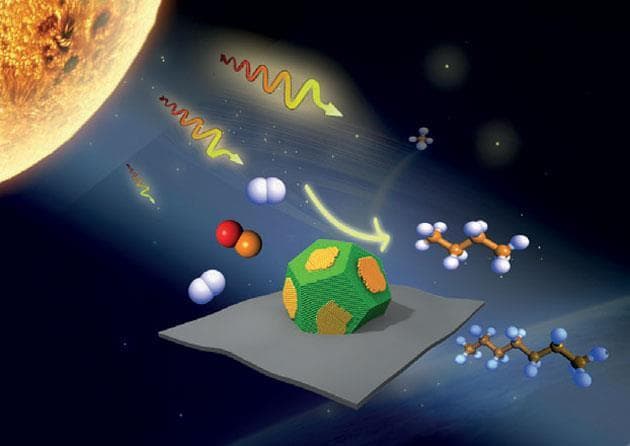IIT Mandi research team 2020: Design a great photocatalyst

IIT Mandi research team in collaboration with researchers from Yogi Vemana University have designed a novel photocatalyst that can remove pollutants from water while simultaneously generating hydrogen using sunlight.
The result obtained by IIT Mandi research team has been published in the international journal, ChemPhotChem. IIT Mandi research team comprises Dr. Venkata Krishnan, Associate Professor (Chemistry), School of Basic Sciences, IIT Mandi along with his research scholars Mr. Ashish Kumar, Mr. Ajay Kumar and Dr. M. V. Shankar from Yogi Vemana University along with his research scholar Mr. Vempuluru Navakoteswara Rao.


After all, if plants and trees can use sunlight to carry out life-sustaining chemical reactions, why can’t we do it in the lab?” asks Dr. Venkata Krishnan.
IIT Mandi research team has designed a series of novel and multifunctional nanocomposite photocatalysts by coupling mesocrystals of calcium titanate with edge sulfur atoms enriched molybdenum disulfide and reduced graphene oxide.
A specific and useful example of a photocatalytic reaction is the splitting of water into hydrogen and oxygen.

Although this reaction was demonstrated as early as 1972 by Fujishima and Honda, the inefficiency of the process has been a bottleneck in scaling up the technology for practical applications.
In addition, the researchers have also used these photocatalysts in the degradation of organic pollutants found in water.
Speaking about the work by IIT Mandi research team Dr. Venkata Krishnan said the performance of a photocatalytic reaction depends upon the efficiency with which the photocatalyst converts light energy into photogenerated charges that drives the reaction of interest.


Oxide materials such as titania and titanates are commonly studied photocatalysts, but these materials are often inefficient by themselves because the electrons and holes combine before the reaction can be propelled forward.
Mesocrystals, a new class of ‘superstructures’ made of highly ordered nanoparticles, could limit the recombination of electron–hole pairs because the free electrons that are generated flow between particles before they can recombine with the hole, says Dr. Venkata Krishnan who is the IIT Mandi research team.
It may be known that graphene is the new wonder-material in the field of materials science, ever since its isolation earned the Nobel Prize in 2010.


Their combination showed a 33-fold enhanced photocatalytic hydrogen evolution over pure calcium titanate, with apparent light-to-electron conversion efficiencies of 5.4 %, 3.0 % and 17.7 % for light of three different wavelengths, orange light (600 nm wavelength) producing the highest efficiency, said Venkata Krishnan who is a part of IIT Mandi research team.
Dr. Venkata Krishnan attributes the enhancement in photocatalytic performance of their material combination, to three factors.
The three factors are the intimate contact between the three components, which leads to better electron transfer, the high surface area that provides more space for the reaction to take place and specific sites on molybdenum disulfide (MoS2) that act as sticky sites for the positive hydrogen ions that are generated during the reaction, which in turn enhances hydrogen production.
IIT Mandi research team is excited about the future directions to this work. IIT Mandi research team believes that their strategy can be adopted to improve the properties and performance of other mesocrystals, which can lead to the fabrication of low-cost and multifunctional catalysts for diverse applications.
About – IIT Mandi
Since the first batch of 97 students joined in July 2009, IIT Mandi has grown to currently host 125 faculty and 1,655 students who are enrolled in various programmes of studies in undergraduate, postgraduate and research programmes, and 1,141 alumni. IIT Mandi is a fully residential campus with 1.4 lakh sq. m. buildings completed. It has a guest house with 88 rooms, an 750-seater Auditorium, campus school, sports complex and hospital.
IIT Mandi has four Academic Schools and three major Research Centers. The Schools are: School of Computing and Electrical Engineering, School of Basic Sciences, School of Engineering, and School of Humanities and Social Sciences.
The Centers are: Advanced Materials Research Centre (AMRC; set up with an investment of Rs. 60 crore), Centre for Design and Fabrication of Electrical Devices (C4DFED; has Rs. 50 crore worth of fabrication tools), and BioX Centre (has acquired research equipment worth Rs. 15 crore). In 2017, the Department of Biotechnology, Government of India, selected IIT Mandi to lead the prestigious Rs. 10 crore FarmerZone Project.
To cater to the growing and changing needs of Indian industry and the aspirations of students, IIT Mandi has introduced 7 B.Tech., 7 M.Tech., 5 M.Sc., 4 Ph.D., 1 I-Ph.D and 1 M.A programmes in the past 10 years.
The unique, project-oriented B.Tech. curriculum is centered around its 4-year long Design and Innovation stream.
From August 2019, IIT Mandi started 3 new and unique B. Tech. programmes in Data Science and Engineering, Engineering Physics, and Dual Degree in Bioengineering.
Since the inception of the Institute, IIT Mandi faculty have been involved in over 275 Research and Development (R&D) projects worth more than Rs. 120 crore.
In the past 10 years, the Institute has signed Memorandum of Understanding (MoU) with as many as 11 international and 12 national universities.
S Vishnu Sharmaa now works with collegechalo.com in the news team. His work involves writing articles related to the education sector in India with a keen focus on higher education issues. Journalism has always been a passion for him. He has more than 10 years of enriching experience with various media organizations like Eenadu, Webdunia, News Today, Infodea. He also has a strong interest in writing about defence and railway related issues.






